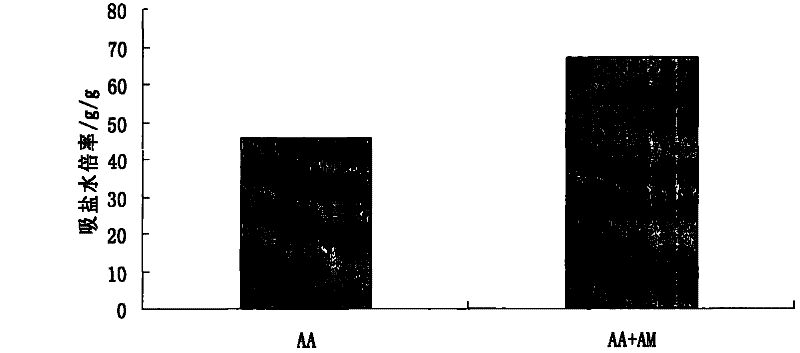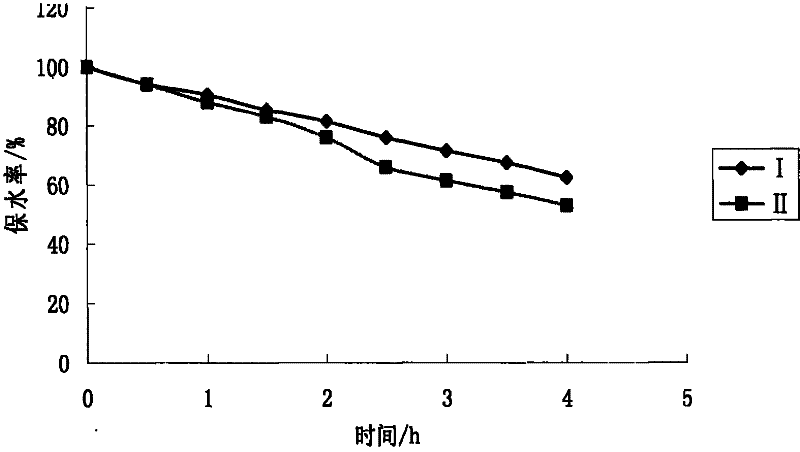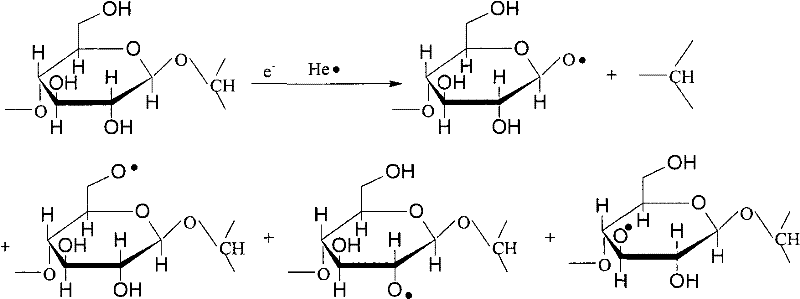Preparation method of cellulose-based water absorbent material
A water-absorbing material, cellulose-based technology, applied in the field of preparation of cellulose-based water-absorbing materials, can solve the problems of difficult measurement, fast water absorption rate, high price, etc.
- Summary
- Abstract
- Description
- Claims
- Application Information
AI Technical Summary
Problems solved by technology
Method used
Image
Examples
Embodiment 1
[0041] Natural cassava stalks, corn stalks, cotton stalks, buckwheat stalks, and eucalyptus cellulose were used as raw materials respectively, and after being pulverized by a pulverizer, fiber materials between 40 and 60 mesh sieves were taken, washed three times with distilled water at room temperature, and then washed with volume Wash twice with 80% ethanol, and dry at 60°C for 10 hours. Take 5g of the above-mentioned treated cellulose and place it in a low-temperature plasma reaction chamber for treatment. The plasma treatment conditions are discharge voltage 150V, vacuum degree 1500Pa, and discharge time 120s. Configure 100mL of monomer solution with a mass concentration of 20%, and then take 2.5g of the above-mentioned treated cellulose in the monomer solution at a ratio of 8:1 by monomer to cellulose mass ratio, wherein the monomer solution is made of acrylic acid It is formulated by mixing with acrylamide at a mass ratio of 1:1. The degree of neutralization of acrylic a...
Embodiment 2
[0044] The bagasse fiber is used as raw material, after being pulverized by a pulverizer, the fiber material with a 40-60 mesh sieve is taken, washed three times with distilled water at room temperature, then washed twice with ethanol with a volume concentration of 80%, and dried at 60°C 10h. Take 5g of the above-mentioned processed bagasse cellulose for processing in a low-temperature plasma reaction chamber. The plasma processing conditions are discharge voltage 50V, vacuum degree 1000Pa, and discharge time 30s. Configure 100mL of monomer solution with a mass concentration of 50%, and then take 12.5g of the above-mentioned treated cellulose in the monomer solution at a ratio of 4:1 by monomer and cellulose mass ratio, wherein the monomer solution is made of propylene Nitrile or acrylic acid or acrylamide with a neutralization degree of 80% or acrylic acid and acrylamide with a neutralization degree of 80% are mixed and prepared at a mass ratio of 2:1, and then the initiator ...
Embodiment 3
[0049] Poplar fiber is used as raw material, after being pulverized by a pulverizer, the fiber material with a 40-60 mesh sieve is taken, washed three times with distilled water at room temperature, washed twice with ethanol with a volume concentration of 80%, and dried at 60°C Dry for 10 hours. 6 parts of 5 g of the treated poplar wood cellulose were respectively taken and placed in a low-temperature plasma reaction chamber for treatment. The plasma treatment conditions were discharge voltage 100 V, vacuum degree 800 Pa, and discharge time 250 s. Configure 6 parts of 100mL monomer solutions with a mass concentration of 10.08% respectively, and then take 1.12 g of the above-mentioned treated cellulose in each part of the monomer solution at a ratio of 9:1 by monomer to cellulose mass ratio. The body solution is prepared by mixing methacrylic acid and methacrylamide at a mass ratio of 2:1, and then adding 6 parts of monomers and cellulose to the mixed solution according to the ...
PUM
| Property | Measurement | Unit |
|---|---|---|
| Water absorption rate | aaaaa | aaaaa |
| Water absorption rate | aaaaa | aaaaa |
| Water absorption rate | aaaaa | aaaaa |
Abstract
Description
Claims
Application Information
 Login to View More
Login to View More - R&D
- Intellectual Property
- Life Sciences
- Materials
- Tech Scout
- Unparalleled Data Quality
- Higher Quality Content
- 60% Fewer Hallucinations
Browse by: Latest US Patents, China's latest patents, Technical Efficacy Thesaurus, Application Domain, Technology Topic, Popular Technical Reports.
© 2025 PatSnap. All rights reserved.Legal|Privacy policy|Modern Slavery Act Transparency Statement|Sitemap|About US| Contact US: help@patsnap.com



